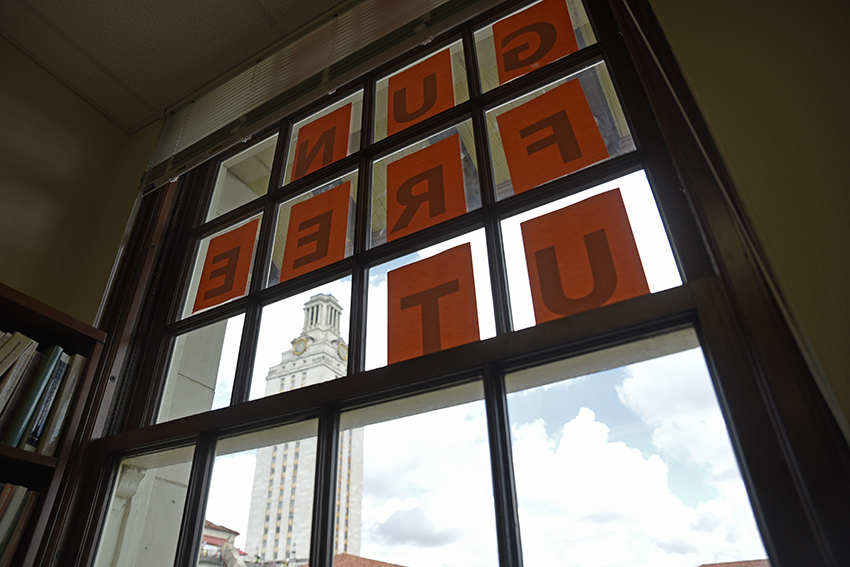Gun free UT signs face removal after University enforces signage policy
September 6, 2018
The University has requested that faculty take down all outward facing signs from office windows by Sept. 7, including signs affiliated with Gun Free UT.
“Consistent with U.S. Supreme Court rulings, the University has policies that use a content-neutral approach based on ‘time, place and manner’ to regulate speech on campus, including the placement of signs,” UT spokesman J.B. Bird said in an email. “The University’s rules do not allow signs on windows that face externally to campus.”
Gun Free UT was organized to bring attention to Senate Bill 11, Texas’ campus carry law, which went into effect in August 2016 and allows licensed handgun owners to carry concealed weapons into public university facilities. The organization provides downloadable signs on its website that have been hung in faculty windows on campus.
Word began to spread among faculty last month that signs featuring the name of the organization, along with any other outward facing signs, needed to be removed, history professor Joan Neuberger said.
“What happened this summer is that the chairs were informed by their deans in a message that came from the president that they wanted us to take the signs down,” said Neuberger, who has a sign hung in her office window. “There was never any official written directive.”
Neuberger said after reaching out to the University, the Legal Affairs office cited University policy to explain the decision, which states that “a University person or organization may display a sign by holding or carrying it, by displaying it at a table or by posting it on a kiosk, bulletin board, or other designated location. Signs may not be staked in the ground or posted in any other location.”
The signs, Neuberger said, began to appear around campus in fall 2015. English professor Lisa Moore, who had Gun Free UT signs in her previous office, said the University recommended removal of signs for several reasons in multiple meetings with departmental leadership and other faculty. But this was the first time the University requested the removal and cited the policy, Moore said.
“They’re citing a policy that was in place long before Gun Free UT came along,” Moore said. “Only now are they saying (it) is a policy that means we can’t put those signs up.”
Bird cited the “proliferation of prohibited signs, including hateful fliers, at UT and on other campuses” for why the University decided to set a deadline for voluntary compliance.
“We have been working closely with deans to request that faculty and staff members remove all signs in outward-facing windows, regardless of the content,” Bird said in an email. “We will continue those efforts towards voluntary compliance.”
Matthew Valentine, a Plan II lecturer and participant in Gun Free UT events, said while the University currently allows faculty to ban guns in their office spaces, the rules surrounding how to designate offices as gun-free are confusing for professors to navigate.
“People have come up with other ways to indicate their displeasure with guns on campus and in their workspaces,” Valentine said. “One of the ways that people have done this is to post Gun Free UT signs, which don’t explicitly say ‘No Guns in My Office’ or ‘No Guns on Campus.’ It’s the name of an organization that they support.”
David Donaldson, a journalism professor who specializes in media law, said to evaluate the University’s decision from a free speech perspective, one must look at if its decision was motivated by something other than an attempt to suppress certain speech.
“(One side of) the argument might be that eliminating these signs is way of promoting a cleaner look, better learning atmosphere for our students,” Donaldson said. “The other side of that (argument could be) because this is a University, a place of learning where people are discovering their own thoughts … you should encourage people to engage in individual speech, which might be a form of putting something out on your window.”











